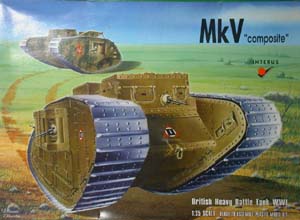Interus 1/35 Mk.V "Composite"
WWI British Tank By Bob Pearson |  | Introduction The classic tank in WWI was the rhomboid-shaped Mk.IV used by the British. However it required a co-ordinated four man team just to operate it. The Mk.V had a new gear-box enabling just one man to do the steering. As with the earlier variants, the Mk.V came in 'Male', 'Female' and 'Hermathodite' varieties. The' Male' had a 6 pdr cannon, the 'Female' machine guns and the 'Hermathodite' (or Composite) carried one sponson armed with a cannon, and one with machine guns. A total of 400 Mk.Vs were produced, and they first saw combat at Hammel on 4 July 1918. Postwar, many saw service in Russia, being used by both sides. The kit Moulded in a dark green plastic, the kit comprises three large sprues that are just packed with parts. There is light flash to most of the pieces, but this is of little concern as a pass with an exacto will clean them up. Of more concern, are the slight sinkholes and indentations from the ejector pins. These cover many of the flat surfaces, and with a model with this much flat surfaces, they may present a problem in a smooth finish. Other detail includes raised seams on the sides, and engraved seams on the top and bottom. Rivets cover the entire model and are uniform in appearance. Edges of plates, hatches and other details are a little soft, and may also benefit with a pass of the tip of a #10 blade. There are five machine gun barrels included. My sample has gaps in three of them. Moving on to the tracks. . my first thought is YIKES .. these are molded in two ways, short sections and iindividually - a quick count shows 86 separate pieces. The instructions show the sequence that they are to be joined together, and they do look better than vinyl ones. The real fun will be the numerous brackets to the road wheels. There are roughly 120 of these tiny items to attach to the outside of the hull. The instructions are in Ukrainian (I think), Russian, English and German, and contain 18 steps with exploded drawings in each one. Seven different marking options are provided for with colours called out in Humbrol paints: -
B Battalion, Hammel, France 1919 -
Armed Forces of the South of Russia 1919 -
3rd tank troop, Gen. Vrangel's Russian Army 1920 -
Red Army, 1920 -
Workers and Peasant's Red Army, 1924 -
On exercise, Russia 1926 -
Worker's and Peasants Red Army, 1929 Conclusion After reading the above, you might think I am critical of this kit. this is far from the truth. Rather it reminds me of the Matchbox/Revell Flower class corvette. Both of them feature somewhat thick injected parts, but with a little work will turn into nice models. I look forward to building this model and adding it to my collection of First World War armour. | 








|








